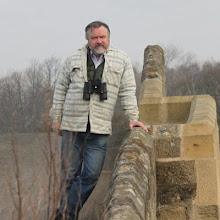
Was out sharp this morning to recover a skull for Northumberland resident bone collector (STH) and as soon as I reached the Carr I was overwhelmed by the chorus of Willow Warbler, Whitethroat, Grasshopper Warbler and new arrival No 94 Sedge Warbler.

As I walked up an old sheep track to the edge of the woods the Grasshoper reel that I thought was near the gate into the field followed me such that fifty yards in it still seemed about twenty feet away to my right. On the edge of the wood I was greeted with a curious look from tufty (anybody my age will remember his road safety guidance which from my experience of Red Squirrels they certainly do not follow) and the click of heels from departing deer. Quickly so as not to create any more disturbance than possible I recovered the skull in question and stopped to listen to the birdsong.

Lots more Willow Warblers, Whitethroats with occasional Goldcrest, Blackcap, another Redstart territory and No 95 Garden Warbler were all identified. Also Robin, Blackbird, Dunnock, Chaffinch, Linnet, Goldfinch and Great Spotted Woodpecker all joined in. Absolute bliss till the bell sounded and I realised that the working day must now start.





Peter,
ReplyDeletenice to see a Red, never seen one there. Might have a wander up there after work tonight to see if the Tawny is there and still havent seen a Sedge Warbler yet.
John
Could you oblige with where the Garden Warbler was, please? My dawn raid on your patch was excellent if not a little shortlived - see http://liverbirder.blogspot.com/2010/04/beautiful-plumage.html
ReplyDeleteUnfortunately it was in the middle of the wood but there's been a territory on the range bridleway next to the ruin for the last two years. Will post when / if the bird arrives.
ReplyDeleteSquirreltastic mate love the Red.
ReplyDeleteHi Peter, Your fungus is a Hoof Fungus or Tinder Bracket (Fomes fomentarius). It's a hoof-shaped fungus. Habitat is deciduous trees, especially birches. Common in Scotland but less so South of the border.
ReplyDeleteThanks Emma. The name certainly is appropriate gievn the look and they are actually harder than a horses hoof! Will have to see how they burn.
ReplyDeleteThe skull is a young Roe Deer but is missing the nose. Poor beast wasn't very old as the teeth aren't worn. Thanks Steve